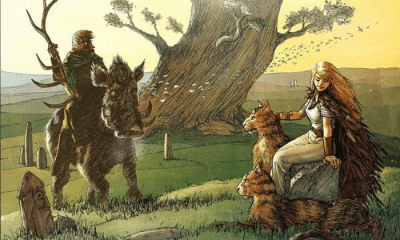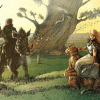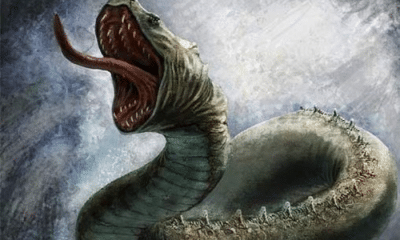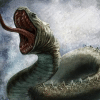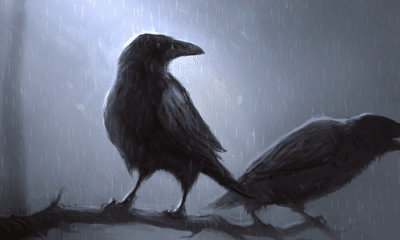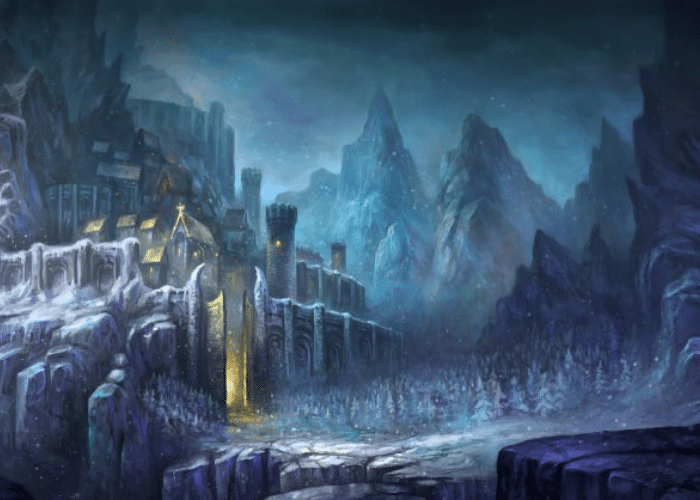
Norse
Niflheim: The Norse Realm of Ice
Niflheim: The Norse Realm of Ice
As a primordial world of ice and the land of the dead, Niflheim played an important role in Norse mythology. Here is everything you need to know about the frozen land of mist!
In Norse cosmology, nine worlds lay along the trunk and branches of Yggdrasil, the World Tree. Seven of these had formed in the void of Ginnungagap, but the two most primordial worlds had been responsible for much of creation.
These worlds were Muspelheim and Niflheim, the lands of fire and ice. From these two elemental worlds came the water and sparks that would be responsible for most of creation.
After the creation of the Nine Worlds, however, Niflheim still had an important part to play in the mythology of the Norse world.
When Loki’s daughter Hel was born as a violent and decaying giantess, Odin banished her from the inhabited realms. She became the queen of a land that bore her name in the world of Niflheim, ruling over the dead in a cold and joyless realm.
The dead would not stay in Niflheim forever, though. Odin’s own journey to Hel revealed to him that Niflheim and its inhabitants would have as much of a role to play in the world’s destruction as they did in its creation.
Niflheim and the Creation of the World
According to the Norse story of creation, Niflheim was the first of the Nine Worlds to be brought into being.
Before the worlds were created, there was only an empty void known as Ginnungagap.
In the north of Ginnungagap there was a spring called Hvergelmir. The northern reaches were so cold, however, that the water of Hvergelmir froze.
This frozen land became Niflheim. It was a frozen world of frost and mist.
The south of Ginnungagap was hot. As it grew hotter it, too, formed a primordial world. This was Muspelheim, the land of fire.
Little of Muspelheim’s heat reached Niflheim, but the slight amount that did caused the ice to drip into Ginnungagap. The droplets of water heated as they fell toward Muspelheim, forming a cloud of vapor in Ginnungagap.
This vapor eventually coalesced into a form. This was Ymir who was a great jötunn, a word often translated into English as “giant.”
When Ymir was killed his body was used to create Midgard, the world of men.
Hvergelmir continued to drip into the Nine Worlds. The spring in Niflheim was said to be the source of all rivers.
The Land of Hel
The land of ice is often to be considered the land of the dead as well, although this is disputed.
The Norse people did not believe that all people went to the same world after they passed on. Exceptional warriors went to Valhalla, other noble deaths went to Frigg’s hall at Fólkvangr, and those who died by drowning were carried into the sea by Ram.
Others, however, were sent to the realm of Loki’s daughter, Hel.
In some sources, Hel’s hall was the destination for all those who lived and died in unexceptional ways. In others, criminals, outlaws, oathbreakers, and other ignoble sinners were sent to Hel.
Hel’s name is often used as that of her realm, as well. The land of the dead was given other names, however.
One of these was Niflhel, or “Misty Hel.” This is occasionally named as Niflheim as well.
The available descriptions of Hel and her realm further the idea that she ruled in Niflheim. The name of her hall, Éljúðnir, is translated as “damp with sleet” or “sprayed with snowstorms.”
Hel, Niflheim, and Niflhel are often used interchangeably in retellings of Norse mythology. Their exact relationship in ancient Norse thought is unknown.
Niflhel is often described as the lowest level of Hel, although this tiered view of the Underworld may be adopted from other sources. In the Prose Edda and other sources, however, Hel seems to be part of, or at least closely affiliated with, Niflheim.
Snorri Sturluson, the author of the Prose Edda, sometimes states that Hel lies within Niflheim. At other times, however, his description of Hel seems to contradict this, leaving some doubt.
The stories of Ragnarök, the destruction of the world and the gods, reaffirm the idea that Hel ruled from a hall in the land of ice.
Odin’s Trek to Niflheim
One of the most well-known stories of Hel’s realm involved the god Odin.
Odin constantly sought knowledge and wisdom, often going to great lengths to learn secrets that were hidden from others. He gave his eye for a drink from the Well of Mimir and sacrificed himself by hanging on the World Tree for nine days and nights to learn the magic of runes.
In another story, Odin traveled to the realm of the dead to meet with a völva, or wise woman, who was said to have possessed secret knowledge in life. The depth of her wisdom had only grown since her death.
Versions of this story exist in both the Poetic Edda and the collection known as the Codex Regius. The poem is known as the Völuspá, or Prophecy of the Völva.
In a third version, Baldr receives the information as well as Odin. Baldr’s Draumar, or Baldr’s Dreams, has Odin’s son see his father’s meeting with the wise woman in his dreams.
Then Othin rose,
the enchanter old,
And the saddle he laid
on Sleipnir‘s back;
Thence rode he down
to Niflhel deep,
And the hound he met
that came from hell.
-Baldr’s Draumar (trans. Bellows)
The völva does have great knowledge to give to Odin. She tells him about the creation of the worlds and the early actions of the gods. These poems are the best surviving sources for our modern knowledge of these tales.
The völva also tells Odin that she has secret knowledge about him. She knows not only what he has done to earn knowledge, but also what is destined to happen to him.
She reveals to Odin how Ragnarök will unfold, beginning with the death of Baldr. The völva’s knowledge of fate would shape the actions of the gods throughout the rest of mythology.
Ice at Ragnarök
According to the völva Odin met in Niflhel, three cocks would crow to announce the beginning of Ragnarök. One of these, “sooty red” in color, would be from Niflheim.
This was far from the only way in which the land of ice will play a role in the twilight of the gods. The primordial worlds of Niflheim and Muspelheim will be instrumental in the end of the world.
The main forces who will fight against the gods would come from Muspelheim, Jötunheim, and Niflheim. In the stories of Ragnarök, Niflheim is usually equated with Hel.
Before the last war began, Midgard will feel the bite of cold that was usually confined to Niflheim. The world will be gripped by Fimbulwinter, three years of bitter cold that will kill nearly all of humanity.
After Fimblwinter, the jötnar and their allies will begin their assault on Midgard and Asgard. They will bring fire from Muspelheim and ice from Niflheim to destroy the land.
The creatures who are associated with Niflheim and Hel who will emerge at Ragnarök are:
- Garmr – Hel’s guard dog, he is described as blood-stained and “the worst of monsters.” He and the god Tyr will kill each other in the battle.
- The Dead – Those that died in ignoble ways or as criminals will be led forth by Hel and Loki to fight against the warriors of Valhalla.
- Hrym – In some sources the frost jötunn Hryn pilots the ship Naglfar, which is made from the nails of the dead. The home of the frost giants is unclear, but their association with ice makes Niflheim their probable homeland.
- Nidhogg – The serpent is said to chew on the root of Yggdrasil that lays over Niflheim. At Ragnarök he will break free and attack Midgard.
Not all of those to emerge from Hel will be enemies of the gods, however.
Baldr and Höðr will come out of Nifheim as the gods lose their battle. They will make peace with one another and unite with the surviving gods to rebuilt the world and rule over a new pantheon.
Niflheim as a Land of Mists
Niflheim is usually described as a land of snow and ice. Existing sources call it cold and reference frost and ice in relation to it.
The world nifl, however, refers to mist.
Many other Indo-Europeans have cognates of this word that all refer to elements of gloom. The Old English nifol meant “dark,” Greek nephele referred to something being cloudy, and Old Dutch and High German used nebul for fog.
The idea of Niflheim as a place that was both cold and shrouded in mist strengthens the theory that it was also the location of Hel’s realm.
Many Underworlds in ancient mythology are places of darkness, mist, and cold.
In Greece, for example, the realm of Hades was perpetually dark and foggy. The souls of the dead wandered as nearly formless mists.
In ancient Mesopotamia, Kur was a dark cavern far beneath the earth in which the souls of the dead lived out a gloomy, joyless version of their lives on Earth. The Japanese Yomi is similarly shadowed and gloomy.
The mists of Niflheim make it a likely location for the Norse world’s least aspirational form of the afterlife.
The Journey to the Land of Hel
The Norse believed that Hel was a dreary place, but the Underworld and the journey that had to be taken to get there could be made more comfortable.
Much of our knowledge of Viking Age culture comes not from architecture or written records, but from the discoveries of burial sites. The Norse people were buried with grave goods that were intended to accompany them into the next life.
Warriors and rulers were often buried with their weapons and armor in the hopes that they would go to Valhalla or Fólkvangr to fight alongside the gods at Ragnarök. Even those who were destined for Niflheim, however, were usually given objects to make the afterlife more palatable.
These grave goods often reflected a person’s status and position in life. The wealthy would be buried with gold and jewels, for example, so they could enjoy their riches after death.
The wives of kings and rich men often carried mirrors, jewelry, and other decorative items into Niflheim. The lower classes took practical items, such as tools and even cooking pots, so that they could continue to provide for themselves in Hel.
Grave goods have even been found for children, often including the toys that they played with when they were alive.
While these burials provide a wealth of information and valuable artefact, they are not the most famous types of burials from the Viking Age.
When most people think of Viking funerals, they imagine the body being placed on a ship and set aflame. This was one custom in the Norse world, but it was reserved only for kings and the extremely wealthy.
The Poetic Edda gives another example of a Viking cremation.
One of its poems tells the story of Brynhildr as she travels along the road to Hel. She is in a lavish carriage, which had been burned as part of her funeral pyre.
Whether by ship or carriage, those who could afford to take a means of transportation with them were assured of a much easier journey to Niflheim and the realm of Hel.
In some cases, these vehicles were buried rather than burned. Much of our knowledge of Viking Age travel, including modern models of their ships, is based on the knowledge gleaned from lavish burials.
The Dead World of Niflheim
The world of Niflheim was the primordial realm of ice and mist on the northern edge of Ginnungagap. Its water had combined with the heat of Muspelheim, the world of fire, in the creation of Midgard and the other worlds.
Niflheim is also thought to have been the location of Hel, the realm of the dead. This joyless world was sometimes said to be the place for criminals and outcasts, but was more broadly believed to house the souls of all but the most noble men.
Odin himself travelled to Hel to consult a wise woman and learn hidden wisdom. There, he learned not only about the creation of the world but also about its destruction.
At Ragnarök, Loki and his daughter would lead the dead out of Hel. They would be joined by frost giants, the counterparts of Muspelheim’s fire giants, and the other monsters who inhabited Niflheim.
The gods who had been sent to Hel would also emerge, however. Baldr and his blind brother would rebuild the world and become leaders of a new race of gods.
Niflheim was a desolate place, but the Norse people believed that they could give their loved ones a more comfortable experience by sending them with grave goods. The gold, jewelry, tools, and even vehicles that people of the Viking Age took with them to Niflheim have provided the artefacts that let us understand both life and death in the Norse world.


